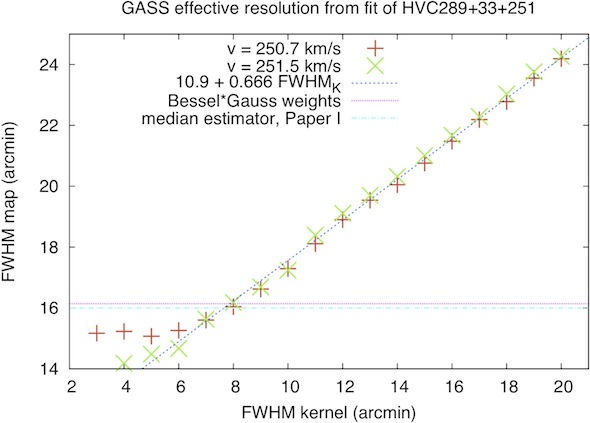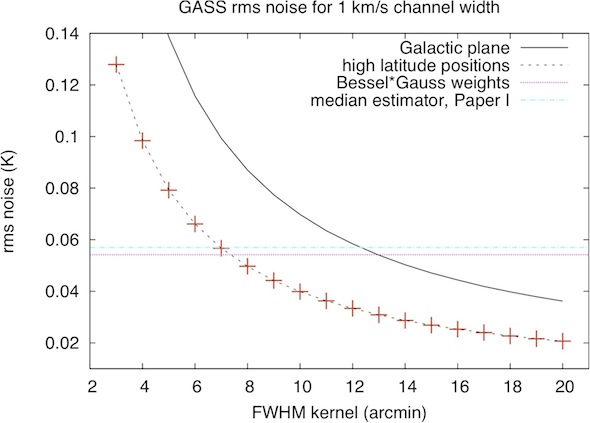GASS Third Data Release 2015-01-15: Data Server
Back to AIfA Hi Surveys Server
Please note:
The datacubes are currently limited to 100.000 pixels per image plane (e.g. 25°x25° ). The calculations take a few minutes, the size of the cubes is up to 120 MB. Requests for GASS FITS cubes are queued. You will be notified via email as soon as your data are available.
Before submission please check your inputs carefully. If you encounter any problems send an email to hisurvey@astro.uni-bonn.de with a full description.
Method
The maps with parameters as specified by you are generated on the fly from the original databases. We provide cubes in Cartesian (CAR) coordinates with "FLAT" projection. For gridding we use a two-dimensional Gaussian with a user-definable width. The kernel FWHM affects both resolution and rms of the FITS cubes - see plots below (e.g. for FWHM = 0.125 deg (7.5 arcmin) one gets an effective beam of 16 arcmin FWHM and a noise level of about 53 mK at intermediate latitudes.) Alternatively you may select an optimized interpolation using a Bessel function tapered by a Gaussian, such as proposed as the default for the AIPS SDGRD routine. Use FWHM = 0 in this case.
Data Products
Cleaned data: Data corrected for stray radiation and cleaned for
RFI.
You can choose between GASS II or III.
Dirty data: These data have been corrected for stray radiation but no RFI was removed.
Stray radiation: The correction that was removed from the data.
Selected velocity range: data are in most cases available for |v| = 495 but may be incomplete for |v| > 468 km/s. The resolution is 1 km/s with a channel separation of 0.82 km/s. The Default is to use the original channel spacing. You may define a larger channel separation: in this case the data are interpolated.
If you want to calculate a column density map simply enter for Δv a large number so that you get only a single channel.
Please specify the parameters of your job below. If not specified otherwise, all angles are given in true angles with respect to the field center.
The processing of your personal data is according to EU regulation 2016/679, see https://astro.uni-bonn.de/en/institute/datenschutzerklaerung. A synchronous data processing is not possible. Therefore it is necessary that you give your e-mail address for a proper processing of your request (for the name you may use a nickname). You will get a notificatinon how to download your data. There is no further processing of personal data except for the case of repeated failure of a request. In this case the e-mail address is used to get in contact to the user for a clarfication what went wrong. Using our service implies that you have given permission to be sent messages related to the processing of your data.
EBHIS is based on observations with the 100-m telescope of the MPIfR (Max-Planck-Institut für Radioastronomie) at Effelsberg. GASS was observed with the Parkes Radio Telescope as part of the Australia Telescope which is funded by the Commonwealth of Australia for operation as a National Facility managed by CSIRO.
Observations and first data release are described by McClure-Griffiths et al. (2009). The Second data release, including correction for stray radiation, instrumental baseline, and RFI contamination is described by Kalberla et al. (2010).
References
If you use GASS data products in your research or publications, please reference the following:
Kalberla, P.M.W. and Haud, U. (2015) A&A 578, A78 (Highlight: Gass: The Parkes Galactic All-Sky Survey. III)
Kalberla, P.M.W., McClure-Griffiths, N.M., Pisano, D. J. Calabretta, M. R., Ford, H. Alyson, Lockman, Felix J., Staveley-Smith, L., Kerp, J., Winkel, B., Murphy, T., Newton-McGee, K. (2010) A&A, 512, A14 (Highlight: Gass: The Parkes Galactic All-Sky Survey. II)
McClure-Griffiths, N. M.; Pisano, D. J.; Calabretta, M. R.; Ford, H. Alyson; Lockman, Felix J.; Staveley-Smith, L.; Kalberla, P. M. W.; Bailin, J.; Dedes, L.; Janowiecki, S , Gibson, B.K., Murpy, T., Newton-McGee, K. (2009) ApJS, 181, 398 (http://adsabs.harvard.edu/abs/2009ApJS..181..398M)
Data from the first data release are available at http://www.atnf.csiro.au/research/GASS/index.html
GASS III Videos (see Sect. 3.2 of the GASS III paper)
http://www.astro.uni-bonn.de/hisurvey/gass/GASS2-3.avi
http://www.astro.uni-bonn.de/hisurvey/gass/GASS3noise.avi
GASS II Videos
Below you will find videos showing a sweep in velocity through the data cube of the GASS survey; clean data (22 MB), stray radiation (6 MB), and RFI that was removed (83 MB).
http://www.astro.uni-bonn.de/hisurvey/gass/clean.mpg
http://www.astro.uni-bonn.de/hisurvey/gass/stray.mpg
http://www.astro.uni-bonn.de/hisurvey/gass/dirt.mpg
Additional plots

Effective FWHM resolution of GASS images as a function of the user-definable Gaussian interpolation kernel. For comparison we show the effective resolution obtained by median gridding and by Bessel interpolation (horizontal lines). The Bessel interpolation can be selected by defining FWHM = 0.

Effective rms uncertainties of GASS channel maps with 1 km/s velocity resolution as a function of the user-definable Gaussian interpolation kernel. Crosses indicate fitted values determined at high Galactic latitudes, the solid black line represents upper limits of the noise, valid for most of the positions in the Galactic plane. For comparison we show the effective noise at high latitudes obtained by median gridding and by Bessel interpolation (horizontal lines). The Bessel interpolation can be selected by defining FWHM = 0.
Webinterface created by Peter Kalberla